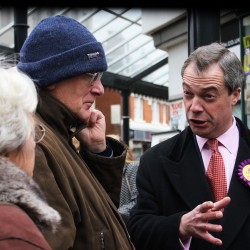By Steve Fenton (University of Bristol) and Robin Mann (WISERD, Bangor University)
Academic analysis and media commentary have shifted the emphasis from Tory voter defectors towards working class voters, and potential Labour supporters, in explaining UKIP support. This was a good corrective to earlier emphases. But has the new focus on working class voters and UKIP support left some gaps in the picture? As Evans and Mellon have already pointed out, UKIP support is found across all classes, with about 50% of its potential votes coming from groups other than the working classes. The second wave of the British Election Study panel survey (fielded between May and June 2014) shows 14.4% of respondents intending to vote UKIP at a general election (including respondents saying ‘don’t know’ or ‘will not vote’. What can closer analysis tell us about higher class support for UKIP? Of the four middle and upper class groups (NS-SEC 1-4), the percentage of each class backing UKIP is as follows:
It is the managers and employers in large organisations (1.1) and small employers (4) who give votes disproportionately to UKIP. Now, 1.1 is a small class; it constitutes only 2.5% of the population. For this reason alone, it is not surprising if these voters gather less attention. But sociologically it is an interesting class, representing as it does some people of power and influence. It is worth knowing more about their political intentions. Moreover, the Higher Professionals (1.2) group is also relatively small (5.5% of all), but notably different from Employers and Managers in their support for UKIP.
Ford and Goodwin have argued that UKIP support comes from those who feel ‘left behind’, with good examples being older working class men in de-industrialising areas of the country. They were also able to show that UKIP gain votes from ‘economically insecure’ voters who gave pessimistic evaluations of their personal economic position, or of the state of the national economy. So, how is a sense of economic insecurity distributed across social classes? The following figure is based upon responses to the question ‘How does the financial situation of your household compare with it was 12 months ago? (Has it: Got a lot worse; got a little worse; stayed the same; got a little better; don’t know). This figure compares those responses across social class categories.
Across all classes, 39% evaluate their personal economic position as having got worse (summing the % saying their personal economic circumstances had got ‘a lot worse’ and those saying ‘a little worse’). In the three working class groups (5, 6 and 7) 42%, 45% and 47% respectively thought that things had got worse for them. In a period when wages have fallen consistently behind rises in the cost of living, this is not surprising. Yet 41% of higher employers and managers also viewed their economic position as having got worse, with the other higher classes each slightly below the percentage for the total. So does the significance of feeling economically insecure for voting UKIP apply also to the middle and higher classes? The following figures report the intention to vote for UKIP (purple bars) alongside the intention to vote Conservative (blue bars) and Labour (red bars), for each of the class groups highlighted above. The first figure reports the results irrespective of their perception of their personal economic circumstances. The second figure reports the results for respondents who said their economic circumstances were worsening.
For each class, we find that UKIP has about 4-8% more support among those who perceive their economic conditions as worsening. Moreover, whilst Labour gains from ‘economic insecurity’ (their votes rise among the economically insecure in all classes), the Conservative vote dips in all classes including the middle and higher class groups. When we look at just the economically insecure in the two employer classes (1.1 and 4), we find that support for UKIP rises from 20% overall to 28% (1.1) and 17% to 21% (4). Economic insecurity means gains for UKIP and Labour in all classes, yet sizeable losses for the Conservatives.
Whatever the influence of so-called ‘cultural factors’ which are known to influence UKIP support, personal economic evaluation has a marked relationship with voting intention, and in the middle and higher classes at least as much as among the working class. All of the higher class groups show UKIP support, but this support is most notable for large employers and managers and small employers, especially when they are feeling ‘worse off’. Conversely, the pattern of intended voting in the professional and intermediate classes gives some support to the argument that professional classes are more ‘liberal’ or ‘left’ than other sections of the middle and higher classes. Similarly, the support for UKIP from Class 4 – Small employers– mirrors support for right wing populist parties in continental Europe.
There may well also be some gloomy indications for UKIP in all this. The fact that its vote is spread across all classes may be a weakness when it faces the question of addressing issues other than immigration and the European Union. And it could stand to lose the chunk of its vote which arises from economic insecurity if the Conservatives can engineer an economic upturn, or if Labour can become a more credible alternative than it is at present.
Notes: All data weighted using “wt_full_W2”. For all analysis, respondents reporting ‘I would not vote’ and ‘don’t know’ are included in percentage totals.




